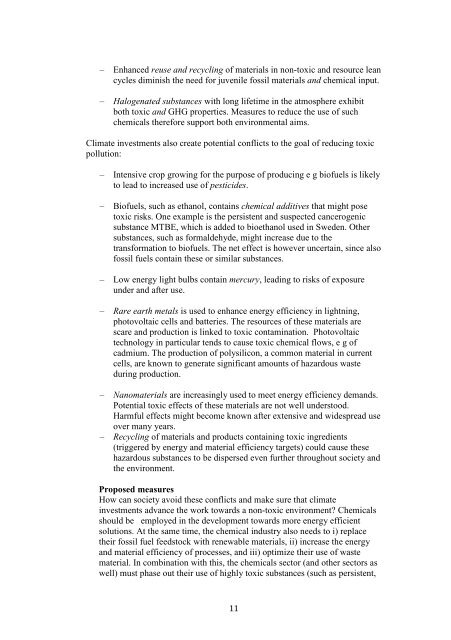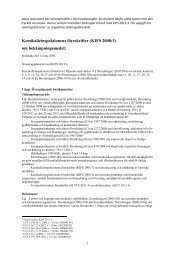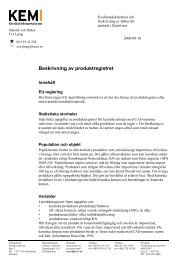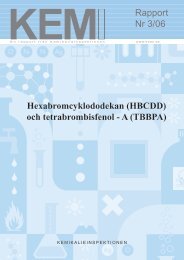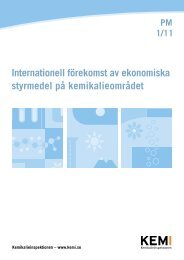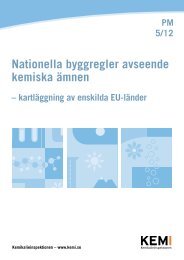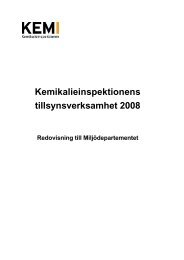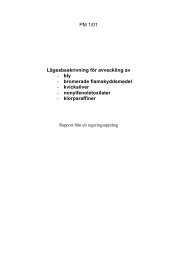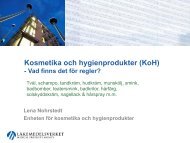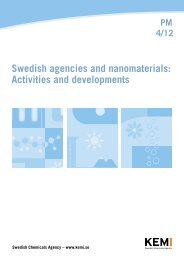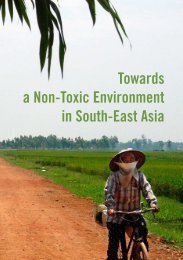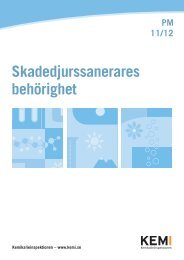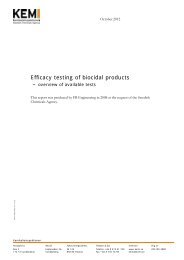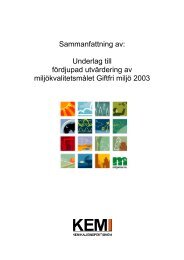Kemikalier och klimat - Kemikalieinspektionen
Kemikalier och klimat - Kemikalieinspektionen
Kemikalier och klimat - Kemikalieinspektionen
Create successful ePaper yourself
Turn your PDF publications into a flip-book with our unique Google optimized e-Paper software.
– Enhanced reuse and recycling of materials in non-toxic and resource lean<br />
cycles diminish the need for juvenile fossil materials and chemical input.<br />
– Halogenated substances with long lifetime in the atmosphere exhibit<br />
both toxic and GHG properties. Measures to reduce the use of such<br />
chemicals therefore support both environmental aims.<br />
Climate investments also create potential conflicts to the goal of reducing toxic<br />
pollution:<br />
– Intensive crop growing for the purpose of producing e g biofuels is likely<br />
to lead to increased use of pesticides.<br />
– Biofuels, such as ethanol, contains chemical additives that might pose<br />
toxic risks. One example is the persistent and suspected cancerogenic<br />
substance MTBE, which is added to bioethanol used in Sweden. Other<br />
substances, such as formaldehyde, might increase due to the<br />
transformation to biofuels. The net effect is however uncertain, since also<br />
fossil fuels contain these or similar substances.<br />
– Low energy light bulbs contain mercury, leading to risks of exposure<br />
under and after use.<br />
– Rare earth metals is used to enhance energy efficiency in lightning,<br />
photovoltaic cells and batteries. The resources of these materials are<br />
scare and production is linked to toxic contamination. Photovoltaic<br />
technology in particular tends to cause toxic chemical flows, e g of<br />
cadmium. The production of polysilicon, a common material in current<br />
cells, are known to generate significant amounts of hazardous waste<br />
during production.<br />
– Nanomaterials are increasingly used to meet energy efficiency demands.<br />
Potential toxic effects of these materials are not well understood.<br />
Harmful effects might become known after extensive and widespread use<br />
over many years.<br />
– Recycling of materials and products containing toxic ingredients<br />
(triggered by energy and material efficiency targets) could cause these<br />
hazardous substances to be dispersed even further throughout society and<br />
the environment.<br />
Proposed measures<br />
How can society avoid these conflicts and make sure that climate<br />
investments advance the work towards a non-toxic environment Chemicals<br />
should be employed in the development towards more energy efficient<br />
solutions. At the same time, the chemical industry also needs to i) replace<br />
their fossil fuel feedstock with renewable materials, ii) increase the energy<br />
and material efficiency of processes, and iii) optimize their use of waste<br />
material. In combination with this, the chemicals sector (and other sectors as<br />
well) must phase out their use of highly toxic substances (such as persistent,<br />
11


